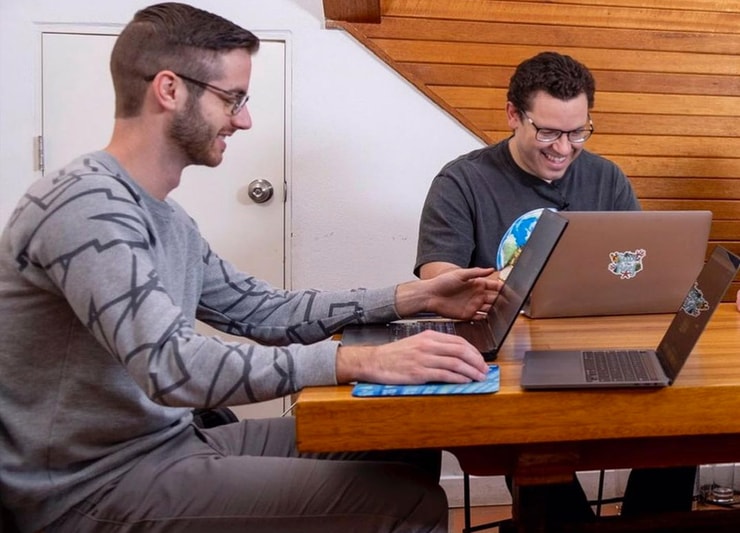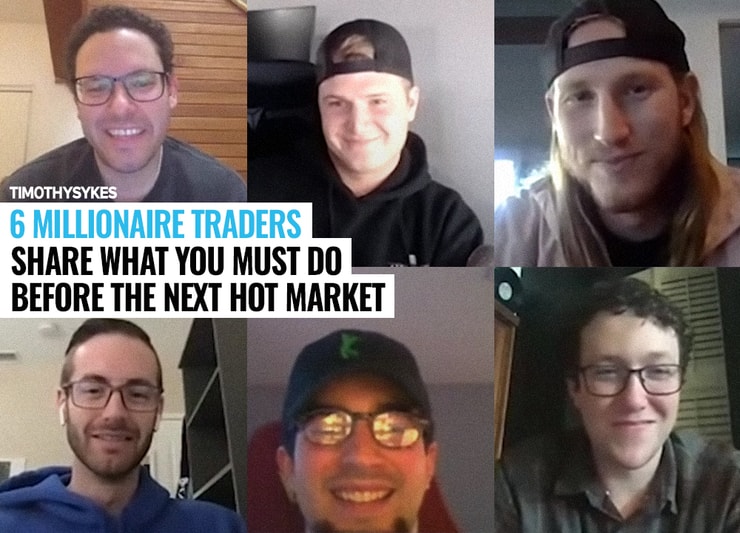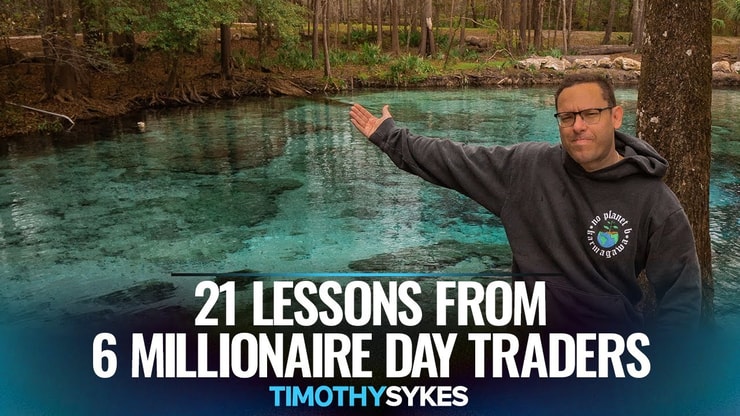What You MUST Do Before the Next Hot Market: Key Takeaways
- Learn the lessons my students used to crush the 2020 market…*
- Top tips for new traders — discover what these millionaires wish they knew when they started…
- It’s not just studying — find out all the ways you can grow as a trader…
Ready to learn to trade through ANY kind of market? Apply for my Trading Challenge here.
Learning from one great trader is good … but learning from six? That’s an optimal trading education experience! These millionaire students prepared for and crushed it in the 2020 hot market.* Now, they have 21 essential lessons to help you prepare for the next one.
Table of Contents
- 1 Lessons From 6 Millionaire Traders
- 1.1 #1. Focus on the Process
- 1.2 #2. Stay Humble
- 1.3 #3. Learn Different Strategies
- 1.4 #4. Keep Things in Perspective
- 1.5 #5. Have the Right Mindset
- 1.6 #6. Focus on Repeatable Patterns
- 1.7 #7. Stay in Your Lane
- 1.8 #8. Don’t Try to Guess the Bottom Or the Top
- 1.9 #9. Keep a Focused Watchlist
- 1.10 #10. Avoid Overtrading
- 1.11 #11. Use the Sykes Sliding Scale
- 1.12 #12. Use the Right Position Size
- 1.13 #13. Consider Your Risk Tolerance
- 1.14 #14. Consider the Big Picture
- 1.15 #15. Focus on Learning
- 1.16 #16. Stay Motivated
- 1.17 #17. Prepare for the Next Hot Market NOW
- 1.18 #18. Maximize Every Single Day
- 1.19 #19. Start Today
- 1.20 #20. Surround Yourself With Successful People
- 1.21 #21. Take Advantage of Every Opportunity
- 2 Kick Start Your Trading Education Today
Lessons From 6 Millionaire Traders
All my millionaire students learned penny stock patterns and strategies in my Trading Challenge. It isn’t easy, and it’s not for everyone. But these students prove that hard work and dedication can pay off.*
Here’s what every trader must do before the next hot market…
#1. Focus on the Process
Every trader has to find what works for them. It starts with your trading education. Sorry, no shortcuts to success.
Focus on the process, not the money. The money can come after years of practice and study, but there are no guarantees in trading.
#2. Stay Humble
If you’re not humble, the market will humble you.
Remember that one trade won’t make you rich, but one bad trade can take you out of the game.
You never know how long a hot market will last. Be grateful for every opportunity.
More Breaking News
- Can Hyzon Motors’ New Fuel Cell Spark a Stock Surge?
- Denison Mines Corp Stock: Is It On The Edge Of A Boom Or A Bust?
- GRI Bio’s Latest Breakthrough in Fibrosis Treatment Boosts Stock: Is This a Game-Changer?
#3. Learn Different Strategies
There’s a time to go long in the market and a time to go short.
Huddie and Kyle are primarily short sellers. But when the hot market came, Kyle says shorting was “quite painful.” They both adapted their strategies to focus on long setups.
Be ready and willing to adapt!
#4. Keep Things in Perspective

The 2020 hot market taught a lot of traders bad habits. Many traders made money without rules or strategies. But a lot of traders — and even hedge funds — lost.
Don’t get caught up in chat room and Twitter hype. Keep things in perspective and focus on your setups and executions. Rinse and repeat.
#5. Have the Right Mindset
Don’t go all in, use leverage, or gamble on stocks going to the moon.
Take it one trade at a time. Practice good trading habits, swing for singles, and stay disciplined.
#6. Focus on Repeatable Patterns
Instead of chasing random spikes, focus on perfecting one or two repeating patterns. That’s how you’ll make it in this game long term. Build a solid foundation of knowledge.
Find what you’re comfortable with and tune out the noise. Then…
#7. Stay in Your Lane
Once you have a few setups you’re good at — stick with them. If you don’t know what you’re good at, test until you do.
My top students still focus on dip buys, breakouts, and the first red day.
Jack Kellogg has made over $8 million in profits and still trades my 7-step pennystocking framework pattern.*
Keep it simple and stick with what works for you.
#8. Don’t Try to Guess the Bottom Or the Top

Dip-buying panics? Don’t try to guess the bottom.
Jack advises, “Look at the history of the stock. Has it had fake turns before?”
Dom says, “If you’re buying panics 3%, 4%, 5% down, you’re going to get caught in a lot more fake turns.”
Also, accept that some stocks won’t bounce. Be ready to cut losses quickly.
And when it comes to exits, don’t try to guess the top. Sell into strength and aim to take the meat of the move.
#9. Keep a Focused Watchlist
Personalize your watchlist to a few stocks that fit YOUR best setups. Don’t try to watch every hot stock.
Like Jack says, “You can only trade multiple patterns at the same time after you’ve done it for so long.”
#10. Avoid Overtrading
My #1 problem is overtrading. That’s why I’d rather miss plays than overtrade. It’s also why I only focus on A+ setups.
Everyone has their own strengths and weaknesses. Again, find what works best for you.
#11. Use the Sykes Sliding Scale
Jack uses the Sykes Sliding Scale to manage expectations and plan every trade.
He says, “Everything goes into it. What time of day is it? Is there a catalyst? What pattern is it? What’s my schedule and all that kind of stuff. And I just do that over and over again.”
And here’s another key part of every trading plan…
#12. Use the Right Position Size

The right position size is imperative for risk management.
Huddie took a big loss early in his career. “Once I had lost 25% of my account in two or three weeks, it blatantly scarred me for the next three or four years of my life where I was just scared of size.”
See how fast you can blow up an account? Taking too much size is scary, even for me. Trade small in the beginning and…
#13. Consider Your Risk Tolerance
When Kyle started trading he risked 1% per trade. Jack started with $50–$200 per trade.
Dom also uses a max dollar loss. “I started with $200 risks and everything I do is just dollar risks. So where my entry is and where the risk level is, the difference between that decides how many shares I take.”
Learn about risk management here.
#14. Consider the Big Picture
All my millionaire students studied and practiced for three, four, or five years.* I’ve been trading for 20+ years. Recognize where you are in your journey and where the market is.
This is a marathon, not a sprint. All the years of slow markets, studying, and grinding prepare you for the next hot market.
#15. Focus on Learning

You can’t rush the process. Matt says it best…
“Learn as much as you can. It’s OK to make mistakes. Keep them small, trade small. Because if it takes you two or three years, there will be another hot market. It’s a long-term game.”
In the beginning, your goal should be to survive and learn — not make money.
Here’s Jack’s perspective: “Put your priorities straight. If you really want to make it in this game, you got to put 110% effort in every single day.”
#16. Stay Motivated
Everyone gets into trading for different reasons. Dom wanted a job that doesn’t feel like a job. Now he plays golf, has a boat, and enjoys life.
Huddie thinks trading’s the most freedom you can have. When he crossed a million in profits, he bought himself a fancy suit and a car.*
Jack worked his butt off during the hot market, then took the summer off.
Remind yourself why you want to trade. That’s your motivation to do better every day.
#17. Prepare for the Next Hot Market NOW
You can’t go back in time. You can only put in 100% effort right now. So study everything you can now.
Huddie says if he could go back in time, “The thing that I would tell myself in the first six months is to watch “Trading Tickers”, “How To Make Millions”, and the “Pennystocking Framework”. Study those three DVDs like they’re your bible.”
#18. Maximize Every Single Day

Jack says, “Maximize every single day. Whether it’s learning or if you’re already profitable, try to maximize your patterns. Don’t compare yourself to others. Compare yourself to yourself. How are you doing on your journey?”
Maximize every second, minute, hour, and day for your education. If you haven’t started yet…
#19. Start Today
“The best time to start is today. You’ll thank your future self later,” says Matt.
Do whatever you can to start NOW. Watch my YouTube videos, study my trades, and paper trade on StocksToTrade.**
Do whatever it takes! And always…
#20. Surround Yourself With Successful People
Matt credits a lot of his success to this quote: “You’re the average of the five people you hang out with the most.”
In other words, “Level up your friend group.” Well put, Matt. Learn everything you can from successful traders. Then put the pieces together to suit you.
#21. Take Advantage of Every Opportunity
All my top students maximized opportunities in the hot market. They were ready when preparation met opportunity.
Ready to get started?
Kick Start Your Trading Education Today

These students worked and studied hard for YEARS to become millionaires.* Now they give back to the community with lessons, webinars, and Q&A in my Challenge chat room.
If you want to be part of a community of dedicated traders — apply for my Trading Challenge now.
Leave a comment saying “I will STUDY HARD!” if you appreciate these millionaire traders’ lessons.
Disclaimer
*Results are not typical and will vary from person to person. Making money trading stocks takes time, dedication, and hard work. Individual results will vary. Trading is inherently risky. Before making any trades, remember to do your due diligence and never risk more than you can afford to lose. I’ve also hired Kyle, Jack, Matt, and Huddie to assist in my education business.
**Tim Sykes has a minority ownership stake in StocksToTrade.com.






Leave a reply